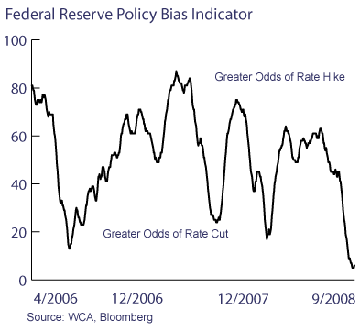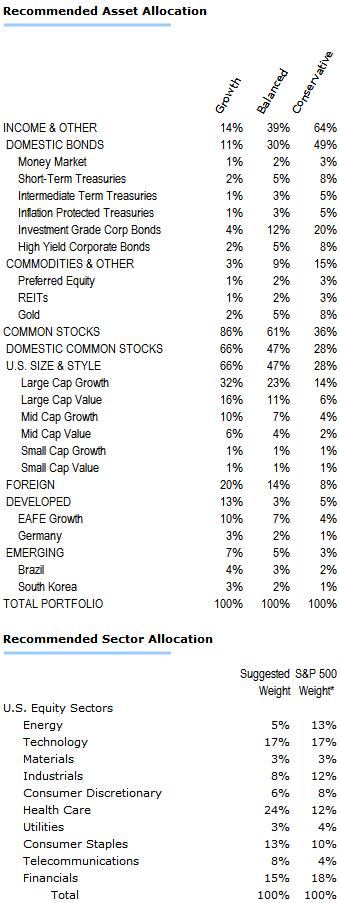Equity Markets Stumble:
Implications for Strategy
The unprecedented series of events of this weekend,
including an expected Lehman bankruptcy, Merrill acquisition
by Bank of America, and AIG’s appeal to the Federal Reserve
for aid is all part of the ongoing de-leveraging of the
economy that we have been discussing for some time. The
implications of this is that the credit system will remain
in a delicate state for an extended period of time, leaving
tighter credit conditions, somewhat higher borrowing cost
for qualified borrowers, and leaving out less qualified
borrowers.
In light of this, our expectation for recovery must now be
pushed out beyond the first quarter of 2009. We are not
changing our asset allocation based upon these events but
have changed the period of time over which we had expected
to increase our equity exposure.
At this juncture, we should take a moment to re-examine some
of the things that the equity markets have going for them
and what continues to work against them:
The equity market a year ago appeared richly valued with the
S&P 500 reaching a peak of 1,565, which was 18.5x our
expected earnings figure of $85 for the full year (keep in
mind that consensus wisdom at the time had earnings for the
S&P 500 well over $100). Today, the S&P 500 is down over
20%, with the financial sector down more than twice that
amount. During this time, Treasury bond prices have risen
and the risk premium paid to own equities, along with many
other kinds of risky assets, has increased. Therefore, an
incentive for new buyers has been reinserted into the
calculus for equity investing.
We estimate, based on a recessionary case for the economy,
that S&P 500 earnings will be closer to $80 in 2008 – a
modest decline from last year’s actual earnings of $82.54 as
reported by Standard & Poor’s on their web site. While
analysts continue to expect a 35% earnings resurgence in
2009 to $106, we find that estimate to be exceedingly
optimistic based on what we expect the economy to deliver in
coming months.
Allowing for the lower interest rate environment and
factoring in much lower than consensus earnings for 2009, we
place a new estimate of the S&P 500’s “fair value” range at
1,260 to 1,390.
This week we should get another installment of quarterly
data on credit demand from the economy in the form of the
Flow of Funds Report. Our readers know that we have been
watching the net new borrowings number from households to
provide us a window into the real condition of the American
household and as an indicator of how deep this credit-driven
contraction will be. We note that, in the past, a two-thirds
contraction in net new borrowing typically marked the bottom
in terms of a credit slowdown. To date, we have seen new
credit demand slip to a 3% annual growth rate after growing
at closer to 16% at the peak of the housing bubble. Any
outright contraction in this figure would be unprecedented
in modern history and would force us to confront an outright
deflation – something not seen in the United States in over
a generation.
For what it’s worth, we now view further rate cuts a near
certainty. In addition to this weekend’s drama, every
ingredient into our Policy Bias Indicator (seen below) now
signals rate cuts are needed. Specifically, the forward
inflation spread priced into the TIPs market has now
collapsed (now below 2%); the term spread has been moving
sideways for much of the year (rather than rising); the
level of default risk priced into credit markets has been
rising; the cumulative advance/decline line for the major
U.S. exchanges continues to make new lows; and the
trade-weighted value of the dollar has spiked materially
since the housing bailout bill was announced in mid-July.

The earnings correction continues, and we expect it to
continue for several additional quarters. In addition,
analysts seem to be far behind the curve in terms of cutting
their expectations and outlook. From an economy-wide
perspective, for example, after-tax corporate profits
through the second quarter slipped to 9.5% of GDP from its
prior multi-decade peak of 10.9% achieved in the fourth
quarter of 2006. The average ratio has been closer to 6%
since the early 1960s and has been as low as 3%. While
peak-to-trough cycles for profits can last for several
years, typically the negative effect of slipping profits on
stock prices abates once investors and analysts adjust
expectations accordingly. Unfortunately, we believe that
there is further adjustment ahead.
Another spot to check is consumer confidence as a barometer
for economic conditions and attractive entry points to
markets during times of distress. Since past recessions
usually last for a year or more, and since markets
anticipate economic recovery about halfway through, it is
interesting that markets tend to perform best from periods
of very low optimism, which are often associated with low
points or panic in the economy. Current readings on
confidence are very low indeed and near every past recession
bottom since 1969. A long-run-oriented and contrarian
investor (with much fortitude) would tend to find this
environment an attractive one to build positions in
anticipation of recovery in years ahead despite the ominous
overtones in the economy and media.
Housing remains a serious concern to us as the supply of
homes for sale remains excessively high and signals further
deterioration in prices ahead. Of course, such deterioration
is not a welcome forecast for banks and investment banks who
are hoping for stability in order to stop the erosion of
bank capital. Such erosion has the immediate effect of
unleashing the kind of chaos now playing out among venerable
Wall Street financial institutions but also has the
potential to seriously inhibit a recovery in credit
availability and the broader economy in the years ahead.
That outcome could materially affect the outlook for
equities if such credit availability becomes increasingly
scarce.
The events currently unfolding are part of the de-leveraging
process that the economy must now endure. The process is far
from complete, and the secondary, fallout effects on the
economy are not yet fully determinable. What is clear is
that this process is not optional, but mandatory, and the
ultimate course this will run is unknowable with certainty.
We also know that the vetting of issues and the weight of
market forces will cause uncertainty to be removed over time
one issue at a time.
After a careful review of these and other considerations, we
are making no immediate change to our asset allocation as
the result of the current volatility. However, we now expect
that secondary effects as the result of the fallout of the
de-leveraging process will extend the timeline for recovery.
Therefore, while we continue to look to add to our equity
position over time, the pace of such additions will likely
be slower than previously envisioned.
 |
Past Commentaries
September 9, 2008
No Change in Portfolio Strategy Despite Treasury GSE
Action
More
July 31, 2008
Quick Take on GDP Report
More
July 21, 2008
Valuation Are Better, But Markets Are Not Out of the
Woods
More
May 20, 2008
Buy the Dips
More
March 10, 2008
Investing During Recession
More
January 22, 2008
Global Sell-off
More
December 27, 2007
Outlook 2008
More
December 7, 2007
NBER President Raises Recession Concerns
More
November 28, 2007
Equity Risk Heightened - Allocation Remains Defensive
More
September 25, 2007
After the Rate Cut
More
July 30, 2007
The Case For Growth
More
June 15, 2007
Data Affirms Tactical Asset Allocation Posture
More
March 19, 2007
Cutting Earnings And Equity Target
More
| |
To unsubscribe, please click here.
Company Name, Address and Contact Details
The information contained herein has been prepared from sources believed to be
reliable but is not guaranteed by us and is not a complete summary or statement
of all available data, nor is it considered an offer to buy or sell any
securities referred to herein. Opinions expressed are subject to change without
notice and do not take into account the particular investment objectives,
financial situation, or needs of individual investors. There is no guarantee
that the figures or opinions forecasted in this report will be realized or
achieved. Employees of Stifel, Nicolaus & Company, Incorporated or its
affiliates may, at times, release written or oral commentary, technical
analysis, or trading strategies that differ from the opinions expressed within.
Past performance is no guarantee of future results. There are special
considerations associated with international investing, including the risk of
currency fluctuations and political and economic events. Investing in emerging
markets may involve greater risk and volatility than investing in more developed
countries. Due to their narrow focus, sector-based investments typically exhibit
greater volatility. Small company stocks are typically more volatile and carry
additional risks, since smaller companies generally are not as well established
as larger companies. Property values can fall due to environmental, economic, or
other reasons, and changes in interest rates can negatively impact the
performance of real estate companies. When investing in bonds, it is important
to note that as interest rates rise, bond prices will fall. High-yield bonds
have greater credit risk than higher quality bonds. The risk of loss in trading
commodities and futures can be substantial. You should therefore carefully
consider whether such trading is suitable for you in light of your financial
condition. The high degree of leverage that is often obtainable in commodity
trading can work against you as well as for you. The use of leverage can lead to
large losses as well as gains. Indices are unmanaged, and you cannot invest
directly in an index.
Stifel, Nicolaus & Company, Incorporated | Member SIPC & NYSE |
www.stifel.com |